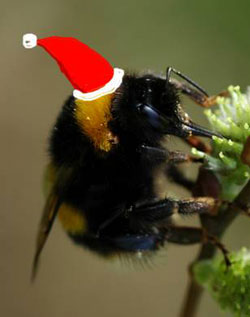Christmas Buzz

Driven by climate change, and by planting of exotic garden plants that flower through the winter, one species of bumblebee seems to have given up hibernating altogether. The buff-tailed bumblebee is a typical large yellow-and-black stripy bumblebee. Like other bumblebees, it is only normally seen from about April to September, spending the autumn and winter asleep underground. But for a few years now, confused bees have been seen in winter on the south coast of England.
This winter, the Bumblebee Conservation Trust based at University of Stirling has been sent reports of winter bumblebees as far north as Nottingham and York, suggesting that the phenomenon has spread several hundred miles northwards. It seems that, as the climate warms and winters become much milder, the bees are taking advantage and trying to breed through the year. So this year, if you feel the need for a bit of fresh air after your Christmas lunch, give the Queen’s speech a miss and go out into the garden and see if you can spot a bumblebee.
Professor Dave Goulson, of the University’s School of Biological and Environmental Sciences and the Bumblebee Conservation Trust and, said: “At a time when most of our bumblebee species are undergoing devastating declines it is good to hear that at least one species seems to be thriving, and adapting to our changing climate. However, we are concerned that there may be knock-on effects for other rare bee species. We are very keen to hear how far this has spread, and would welcome records from anyone who sees bumblebees in their garden this winter, particularly those in the North of England, Wales or Scotland.”
While the buff-tailed bumblebee is thriving, the picture is not so cheery for other bumblebee species.
Professor Goulson said: “Many bumblebee species are undergoing catastrophic declines across Europe, with three species now extinct in the UK and several more heading that way. The main cause is loss of hay meadows and flower-rich grasslands to intensive agriculture. We can all help by planting wildflowers and cottage-garden flowers such as foxgloves, lupins and lavender in our gardens.”
Professor Goulson will give a free public lecture entitled Where have our bumblebees gone? on Wednesday 13 December 2006 at 4.00 – 5.00 pm in the Logie Lecture Theatre, University of Stirling.
Media Contact
More Information:
http://www.bumblebeeconservationtrust.co.ukAll latest news from the category: Ecology, The Environment and Conservation
This complex theme deals primarily with interactions between organisms and the environmental factors that impact them, but to a greater extent between individual inanimate environmental factors.
innovations-report offers informative reports and articles on topics such as climate protection, landscape conservation, ecological systems, wildlife and nature parks and ecosystem efficiency and balance.
Newest articles

Bringing bio-inspired robots to life
Nebraska researcher Eric Markvicka gets NSF CAREER Award to pursue manufacture of novel materials for soft robotics and stretchable electronics. Engineers are increasingly eager to develop robots that mimic the…

Bella moths use poison to attract mates
Scientists are closer to finding out how. Pyrrolizidine alkaloids are as bitter and toxic as they are hard to pronounce. They’re produced by several different types of plants and are…

AI tool creates ‘synthetic’ images of cells
…for enhanced microscopy analysis. Observing individual cells through microscopes can reveal a range of important cell biological phenomena that frequently play a role in human diseases, but the process of…





















